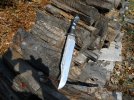- Joined
- Nov 20, 2008
- Messages
- 10,188
I recently finished a 12" W2 bowie. During my chopping test on an oak limb I got some minor chipping. On examination, I noticed I had put a very long shallow v-grind on, similiar to the edge of a meat slicer. I re-profiled the edge and retested, and got no chipping at all.
I heat treated by bringing it up to critical and holding for five minutes or so, then quenched in parks 50. I tempered at 425 for an hour, cooled, and repeated.
I've put the blade through a series of chopping tests and the blade has performed satisfactorily. Still, that initial episode of chipping bothers me. Do you guys think it was caused by testing with an inappropriate edge grind, or could I have missed on my HT? Picture attached.
I heat treated by bringing it up to critical and holding for five minutes or so, then quenched in parks 50. I tempered at 425 for an hour, cooled, and repeated.
I've put the blade through a series of chopping tests and the blade has performed satisfactorily. Still, that initial episode of chipping bothers me. Do you guys think it was caused by testing with an inappropriate edge grind, or could I have missed on my HT? Picture attached.

